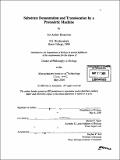Substrate denaturation and translocation by a proteolytic machine
Author(s)
Kenniston, Jon Anders
DownloadFull printable version (8.661Mb)
Other Contributors
Massachusetts Institute of Technology. Dept. of Biology.
Advisor
Robert T. Sauer.
Terms of use
Metadata
Show full item recordAbstract
Many AAA+ molecular machines generate power and drive cellular processes by harnessing energy from cycles of ATP hydrolysis. ClpX is a relatively simple AAA+ ATPase that powers regulated protein degradation by binding native protein substrates, denaturing them, and translocating the unfolded molecule into the sequestered proteolytic compartment of its peptidase partner, ClpP. Mechanistic studies of ClpXP degradation provide insight into energy-dependent proteolysis and may help elucidate how other AAA+ motors function as well. By studying the ClpXP-mediated degradation of model substrates in native and denatured forms, I investigated the role of both substrate stability and ATP consumption during the individual substrate processing steps of this protease. My results demonstrate that the rate of substrate proteolysis by ClpXP correlates poorly with global thermodynamic stability, but instead appears to be influenced by the local stability of protein structure adjacent to the degradation tag, as well as the location of the tag within this individual local element. These findings support a directional unfolding mechanism whereby ClpXP denatures proteins by first peeling apart the structural elements that abut the recognition tag. Analysis of ATP consumption during denaturation and translocation reveals how the ClpXP motor operates during these ClpXP processing steps. ATP turnover rates are relatively fast during substrate translocation, utilizing about 1 ATP molecule per amino acid translocated. In contrast, ATP hydrolysis remains at a reduced but constant rate during the denaturation of native substrates independent of their intrinsic stability, but requires the hydrolysis of increasing numbers of ATP molecules as the stability of the substrate also increases. (cont.) These findings suggest that ClpXP is capable of denaturing very stable proteins by applying repeated cycles of an unfolding force linked to the cycles of ATP hydrolysis. Competition experiments further reveal that stable substrates are frequently released from CIpXP when they resist denaturation, but unstable substrates are rapidly engaged by the proteolytic machinery. This preference prevents ClpXP from being jammed with substrates that are difficult to unfold. Moreover, it allows the protease to selectively degrade poorly structured substrates that consequently require fewer cycles of ATP hydrolysis, thereby ensuring that the energy of ATP hydrolysis is used efficiently for protein degradation. These mechanistic features could be useful for other AAA+ ATPases that translocate polymers against a force.
Description
Thesis (Ph. D.)--Massachusetts Institute of Technology, Dept. of Biology, 2005. Includes bibliographical references.
Date issued
2005Department
Massachusetts Institute of Technology. Department of BiologyPublisher
Massachusetts Institute of Technology
Keywords
Biology.